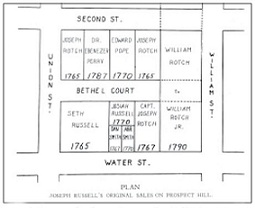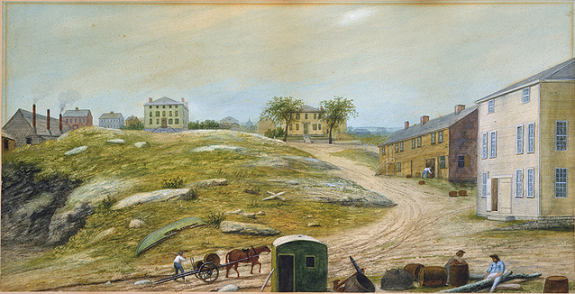William Allen and William Allen
The earliest mention of a William related to the area was the name William Allen, son of George and Katherine. He was born in England in 1629 and departed Weymouth, England with his brother Matthew in 1635. While William Allen himself was not historically associated with Old Dartmouth, his brother Matthew was. It is unlikely, but possible that he named William street after his brother.
There was yet another William Allen, son of Joseph Allen and Sarah Holloway. Joseph Allen was one of the first proprietors of Dartmouth, owning a 1/34th share of the Township. His son William was born in Dartmouth on August, 10 1673.
William Bradford is a famous historical figure with ties to the Dartmouth Township that is familiar to most. He is one of the aforementioned early Dartmouth Proprietors that purchased land in the region in 1652. He is also one of the original Pilgrims that arrived on the Mayflower. His arrival as one of the first Pilgrims, stature, and participation in developing the region make him a good candidate for the naming of William Street.
The next mention of a well-known William is that of King William and King William’s War, which lasted from 1688–1697. King William’s War was the North American theater of the Nine Years War, which was a war between New England and New France, and included the American Indians. We have to recall that at this time in America’s History many settlers were newly arrived from England and still had close ties and loyalty to their sovereign. To name a street, especially one of the original streets would not be that uncommon.

By around the middle of the eighteenth century much of the lands in New Bedford were in the possession of the Russells, to the South, and the Kemptons to the North. We know the boundaries because of confirmatory deeds dated May 25, 1714, that state that the Russells were bounded by a line near Clarke’s Cove on the south, and Kempton by a line near Smith Street; the dividing line was between William and Elm Streets. So there is no doubt by this time that William Street has had its name. The Russells’ land possession included William Street, and there was indeed a William Russell.
The final important William related to the area, is another William Russell. This Russell is responsible for the name of both Bedford and New Bedford and is simply the best candidate for the dubbing of William Street: William Russell, 1st Duke of Bedford. Our Joseph Russell who is responsible for suggesting the name [New] Bedford for the city, suggested the name as a tribute to his own family that had status in England. William Russell, 1st Duke of Bedford was born in 1613 and served as a politician for the majority of his life until his death in 1700 and purportedly had interests in Whaling.
So which “William” is our culprit and responsible for the name William Street? Which is your candidate? Do you have further information that could shine light on the origin? Please e-mail us at nbgarts@gmail.com or comment on this page.
William Street Timeline
1714-Kempton and Allen families have their lands officially deeded and bounded. Boundary is set between Elm and William Streets.
1719-Joseph Russell is born and lives at the head of William Street.
1765-Salisbury, England born and Nantucket whaling merchant, Joseph Rotch buys 10 acres of “New Bedford” land from Joseph Russell III and builds his first home on the west side of Water street just south of William.
1792-1795 William Street is expanded/lengthened.
1792-The first Congregational meetinghouse in New Bedford is built at William and Purchase Streets.
1828-Social Library is located at the Lyceum on 67 William Street.
1829-First Baptist Church is built at 149 William Street
1833-Perry Russell’s prussian-blue works on the corner of William and Sixth street caught fire and burned down. Sixth Street extended from Elm to Middle street.
1834-1836-U.S. Customs House is built on the corner of William and Second streets.
1837-Liberty Hall utilizes the old meeting house of the Unitarian Society at the corner of Purchase and William Street.
1838-City Hall is built where the Free Public Library stands today.
1851-The Congregational and Unitarian Church on the corner of Purchase and William Streets begins to use its bell to warn runaway slaves that U.S. Marshals were coming.
1853-New Bedford Institute for Savings building is erected at the corner of Second and William streets by Russell Warren. Building is currently the New Bedford Whaling National Historic Park.
1863-The corner of William Street and Acushnet Avenue is used to recruit volunteers for the 54th Regiment, which is the first African-American Regiment commissioned in the North.
1877-Citizen’s National Bank is built at 41 William Street. Subsequently becomes the New Bedford Acushnet Cooperative Bank, Haskell’s Bar, the Pequod Lounge, before finally becoming Freestone’s Grill.
1889-The YMCA relocates to 147 William Street.
1893-Liberty Hall is demolished and replaced with the Merchants National Bank.
1897-Lupo’s Restaurant is built on the corner of Acushnet Avenue and William Street.
1906-A fire at the City Hall seated on William Street destroys the building. To continue functioning, City Hall moves across the street to the Free Public Library where it still sits today.
1909-New Bedford High School is built on County Street at the end of William Street.
1910-Former City Hall is finally renovated and opens as the Free Public Library.
1947-Carter’s Clothign and Footwear opens its doors at 55 William Street.
1955-Post Office on Acushnet Avenue and William Street is demolished.
1962-The one ton sea god statue is erected in Tonnessen Park on William Street. It is donated by Ana Hyatt Huntington to serve as a memorial to Whalemen and Fishermen lost at sea.
1971-The New Bedford Institute for Savings Bank at the corner of Second and William streets becomes the Old Third District Courthouse.
1996-The National Historic Park moves into the Old Third District Courthouse on Second and William streets.
2004-Mount Vernon Group razes the Lupo’s Restaurant building site.
 New Bedford Guide Your Guide to New Bedford and South Coast, MA
New Bedford Guide Your Guide to New Bedford and South Coast, MA























What an amazing article!
I am so impressed by this prolific author’s vividness and his ability to make you care about the topic written.
Very uniqe evocative style. I look forward to more articles by Joe Silvia. Well done!
Joe, great read! Can I link my website to you? I have a New Bedford section on my site.
Joe, nice read. Can I link to you from my site? I have New Bedford info too.
Joe, you most certainly can! You may share your link as well.
Mr. Silva (May I call you “Joe”?):
Great writing/great research!
Your articles have touched me in a way. I’ve been meaning to research the origin of some street names in NYC. I’m no writer, but at least I can do some research. Your detective skills are impeccable!
Thank you for inspiration!
~iggy
What about William Rotch Jr., born in Nantucket in 1759, died in New Bedford in 1850?
Hi Matt – I have since come across an Old Dartmouth Historical Sketch that mentions that it was indeed named after William Rotch. Perhaps this is what you came across? I haven’t reconciled it yet – still figuring out whether the street was called William Street before him or not.
Thank you for the comment and interest Mr. Bullard. William Rotch is an influential and important historical figure and one certainly with enough stature, to be the “William” that William Street is named after. However there are historical documents that mention William Street by 1714. William Rotch, hadn’t been born yet. Of course, he was part of the family that Rotch Street, a mile away was named after.
Perhaps a future installment. 😉
Joe:
Great article. Fascinating! Aminor point is that Haskell’s “Bar” was actually Haskell’s Cafe. I was a musician there in the late 60’s at only 16 yrs. old. Had to tell everyone I was 17 in order to accompany my band. Pretty rowdy place at the time!
Thanks Victor! A big thanks for the anecdote as well! Every once in a while I hear a story about Haskell’s and how rowdy it was.
THX JOE IF I MAY CALL YOU JOE I LIVED BOTH IN SOUTH & WEST ENDS YES ON KEMPTON STREET ACROSS FROM ST MARYsHOME NO 624 THE HOUSE STILL THERE AND iN VERY GOOD SHAPE!! I AM 74 NOW LIVING IN nEW HAVEN,CT! NEW BEDFORD WILL ALWAYS BE HOME I AM ALSO DOING GENEALOGY SO THIS ADDS TO mY RESEARCH THX ELEANOR M. TATROaka ARVIE1959@AOL.COM
E-mail sent, Mrs. Tatro!
Great information Joe! I always thought it would make a great topic to trace the origins, history and development of streets. I do a little local history now and then on my blog: http://southcoasthistory.wordpress.com and greater New Bedford baseball history at http://scvbb.wordpress.com
Wow. What a gold mine, Kyle. Fantastic writing! Perhaps we can collaborate on a few streets. You are also more than welcome to write an installment yourself. I will also be doing buildings, monuments, parks, and people in a similar vein.
Thanks Joe. Feel free to drop me a line. I do research and writing in my spare time when I get a chance.
hi there, enjoyed your historical info. would you have any info on the streets between brook and ashley blvd. i grew up on shaw st and have always been curious about the development that took place in that area. i assume it was built as housing for mill workers from the mills along church st. thanks!
Joy, I’m sorry. I never saw this.
Off the top of my head, and I may be wrong, but are you thinking of Bowditch?
I am an International student studying in Umass Dartmouth and I have always wondered why there are names like “Coggeshall” to the streets. I am very glad that you have stared this series. Hoping to read more articles from it very soon. Thank you.
Thanks Gaurev! There is much history in this area to uncover and it seems people are hungry for it. We appreciate your vote of confidence!
I love the way you write. You have a way of engaging your readers. I live in New Bedford and always tell my partner, ” I would love to go back and see what New Bedford was like”. Your articles are the second best thing to actually going back. Please keep writing, I’ll definitely keep reading!
Thanks a ton, Brian. Very thoughtful and I appreciate your kind words! I have hundreds of articles in store and plan on returning to the history articles very soon!
I’m absolutely captivated by all things history of New Bedford. I own and live in a house on County St. and am told was built by a whaling captain named either James or John Barrett. (not sure which) I am fascinated on your research of street names and look forward to the next one.
Hi Joe, a friend of mine said his grandmothers ancestors were one of the first settlers in what is now called New Bedford. He claims that there is a rock near the waterfront in New Bedford with the names of the settlers. He believes the last name was Rickerson. He said his grandmother would take him there when he was very young. He is now 71yrs. old.
He suggested we go to New Bedford some day and try to locate this rock. I was thinking maybe near Fort Tabor? I, being a history buff, got interested in this once he told me. I reside in Johnston, RI and he lives between Newark VT & Johnston. I have done a few Civil War re-enactments at Fort Tabor and have a friend a the War Museum there by the name of Bob Bromely, who is the curator there. I am also an associate member of the museum. I have asked him and he said he has never heard of such a place.
So if you can shed any light on this subject I would really appreciate it.
Hi Arthur,
When he refers to settlers, do you know if he means the Leideners i.e. the nation’s first settler in a specific way or does he mean the Olde Dartmouth Proprietors, meaning the region’s first settlers?
I believe he may be referring to the Ricketsons, not the Rickersons. While a Mary Ricketson came aboard the Mayflower, her surname would have been lost after marriage to a Daniel Wilcox. However, decades later the Ricketsons -a Quaker family – pop up in historical record.
The most notable of whom is Daniel Ricketson (1813-1896), philanthropist lawyer, historian, poet who wrote, in my opinion, the best source on the history of Olde Dartmouth. He had a shanty on the edge of Brooklawn Park, there might be a stone there.
The only other Ricketson that comes to mind that might have his name on a marker somewhere is Joseph Ricketson whose house is still standing on the north side of Union Street between Pleasant and Sixth Streets. He was an abolitionist who hid slaves and his house is part of the Underground Railroad.
Hope that helps. If I drive by these spots in the coming days, I’ll pull over and check.
Hi Joe. Great piece. I grew up in New Bedford and was in the Class of 1972, the last class to graduate from the old New Bedford High on County St.
Question for you, do you have any info on a family named Healey located from the south end of New Bedford?
Supposedly they were linked to whaling and owned large tracts of land in the south end. The family mausoleum is in the Rural Cemetery.